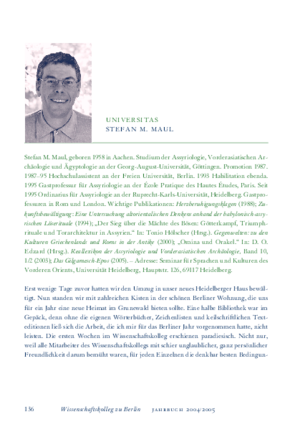
Stefan M. Maul, Dr. phil.
Professor of Ancient Oriental Studies
Ruprecht-Karls-Universität Heidelberg
Geboren 1958 in Aachen
Studium der Assyriologie, Vorderasiatischen Archäologie und Ägyptologie an der Georg-August-Universität, Göttingen
Project
"Breaking the Spell": an Examination of the Oriental Concept of Illness and Cure
Anhand von bisher unveröffentlichten Beschreibungen keilschriftlicher Heilverfahren, die im 2. und 1. vorchristlichen Jahrtausend auf Tontafeln niedergelegt wurden, sollen die weltbildbezogenen assyrisch-babylonischen Konzeptionen von Krankheit und Heilkunst erarbeitet werden, die die Grundlage für die Medizin der klassischen Antike bildeten.Im Mittelpunkt der Untersuchung stehen die in Kompendien zusammengestellten Beschreibungen der Behandlung einer schweren Abdominalerkrankung, die "Bann" genannt wurde. Schon der Name der Krankheit zeigt, dass die mesopotamischen Heiler keineswegs das akute und durchaus charakteristische Krankheitsbild als kennzeichnende Eigenart dieses Leidens betrachteten. Das eigentliche Wesen der als "Bann" bezeichneten Krankheit sahen sie vielmehr in einer massiven Störung im Verhältnis zwischen dem erkrankten Menschen und den Göttern. Das Krankheitsbild entwickelte sich aus der Sicht der mesopotamischen Heiler von ökonomischen Schwierigkeiten über Beeinträchtigungen psychischer Art bis hin zu lebensbedrohlichen somatischen Störungen.
Die langwierigen therapeutischen Verfahren, die die mesopotamischen Heiler empfehlen, sehen nur in ihrem abschließenden Teil die Verabreichung von genau beschriebenen Medikamenten vor. Zuvor wurden mit Mitteln, die Formen der modernen Gestalttherapie nicht unähnlich sind, die tieferen, auf Schuld und Vergehen zurückgeführten Ursachen der Krankheit beseitigt.
Lektüreempfehlung
Maul, Stefan M. Zukunftsbewältigung: Eine Untersuchung altorientalischen Denkens anhand der babylonisch-assyrischen Löserituale (Namburbi). Mainz:
von Zabern, 1994 (Baghdader Forschungen, Band 18).
-. "Der Sieg über die Mächte des Bösen: Götterkampf, Triumphrituale und Torarchitektur in Assyrien." In Gegenwelten: zu den Kulturen Griechenlands und
Roms in der Antike, herausgegeben von Tonio Hölscher, 19-46. München u. a.: Saur, 2000.
-. "Omina und Orakel. A. In Mesopotamien." In Reallexikon der Assyriologie und vorderasiatischen Archäologie, herausgegeben von Dietz Otto Edzard, 45-88.
Berlin und New York: de Gruyter, 2003. (Bd. 10, Lfg. 1+2 Oannes ( Pabilsag[a]).
Colloquium, 07.11.2004
Die "Lösung vom Bann". Überlegungen zu altorientalischen Konzeptionen von Krankheit und Heilkunst
Excavations in Assur-the old capital of Assyria which was captured and totally destroyed by the Medes in 614 B.C.-uncovered hundreds of fragmented clay tablets in the ruins of a private home. These tablets were what remained of the library of a scholar whose professional title in Assyrian was aschipu, which can only be translated with the inadequate term "conjurer-priest" or "exorcist." Examination of the library contents showed that the aschipu-contrary to expectations-was not solely entrusted with the carrying out of magic-religious rituals; a large portion of the remnant library consisted of medical prescriptions of quite rational appearance. Thus was overturned the hitherto seldom contested thesis that when it came to healing arts in the ancient Orient there existed two separate and sometimes competing disciplines, namely that of rational medicine and irrational magic.
In light of this important revelation there should be a reassessment of medicine in the ancient Orient so as to demonstrate the unity of these two forms of therapy which only from our present-day perspective might be understood as separate.
Clay tablets from the library of the "conjurer-priest" of Assur afford us the material for such an investigation, and particularly suitable are the extensive yet still unpublished writings that concern themselves with an illness that was known as mamitu, or "ban." Already the name of the sickness shows that Mesopotamian healers did not regard the acute and wholly typical internal and external symptoms as the defining hallmark of this ailment. The true nature of this illness known as the "ban" lay rather in a violent disruption of the relationship between the sick person and the gods, who in their anger over a certain offense imposed the "ban" on a select individual.
The numerous cuneiform texts that deal with the sickness of the "ban" convey a precise picture of the ancient Oriental healer's notion of how the illness manitu took effect. For the aschipu, the "ban" first manifested itself in infliction of economic hardship on the concerned party, then followed by psychic impairment that would culminate in the life-threatening somatic disturbances of an abdominal ailment.
The lengthy therapeutic process as recommended by Mesopotamian healers only witnessed the ministration of medicine in its final concluding stage. Of course, the physical symptoms of the patient were treated with enemas, herbal compresses, medicinal baths, salves and juices; yet, in the mind of the Mesopotamian healer, the curing of a patient's physical symptoms remained ineffectual if their transcendent cause was not eliminated and a fundamental harmony restored between the patient and the divine. Employing methods not dissimilar to forms of modern Gestalt therapy, the deeper causes of this sickness-guilt and misdemeanors-would consequently be removed.
Eveningcolloquium , 21.04.2005
Vom Bild zum Wort. Die Erfindung der Schrift
Publications from the Fellow Library
Maul, Stefan M. (Tokyo, 2005)
Die Inschriften von Tall Ṭābān (Grabungskampagnen 1997 - 1999) : die Könige von Ṭābētu und das Land Māri in mittelassyrischer Zeit Acta Sumerologica : Supplementary series ; 2
Maul, Stefan M. (München, 2005)
Das Gilgamesch-Epos Gilgamesch <dt.>
Maul, Stefan M. (2003)
Maul, Stefan M. (1999)
Gottesdienst im Sonnenheiligtum zu Sippar
Maul, Stefan M. (Mainz am Rhein, 1994)
Zukunftsbewältigung : eine Untersuchung altorientalischen Denkens anhand der babylonisch-assyrischen Löserituale (Namburbi) Baghdader Forschungen ; 18
Maul, Stefan M. (Berlin, 1992)
Die Inschriften von Tall Bderi Die Ausgrabung von Tall Bdēri ; 1
Maul, Stefan M. (Wiesbaden, 1988)
"Herzberuhigungsklagen" : die sumerisch-akkadischen Eršaḫunga-Gebete Herzberuhigungsklagen
